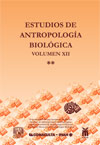Prácticas y creencias religiosas en torno a la muerte: Xcaret en los siglos XVI-XII, Quintana Roo, México
DOI:
https://doi.org/10.22201/iia.14055066p.2005.21593Palabras clave:
prácticas funerarias, sincretismo, aculturación religiosa segregación espacialResumen
Se analizaron 131 osamentas procedentes de la capilla de Xcaret en conjunto con información arqueológica e histórica para conocer cómo se dio el proceso de dominación-subordinación y de aculturación religiosa en esta zona que estaba en relativo aislamiento económico y político. Las evidencias sirvieron también para determinar si se había utilizado un patrón de segregación del espacio funerario por el sexo o la edad del difunto. Los resultados indican una resemantización de los elementos católicos dentro del ritual debida a que los significados católicos y mayas no entraron en contradicción y algunas prácticas católicas ya se hacian igual desde tiempos prehispánicos; además, la elite local fomentó la aculturación religiosa y la edad resultó un factor de segregación más significativo que el sexo en la localización de las tumbas.
Descargas
Descargas
Cómo citar
Número
Sección
Licencia

http://creativecommons.org/licenses/by-nc-nd/4.0/


